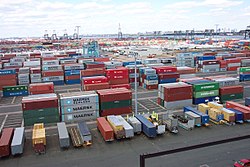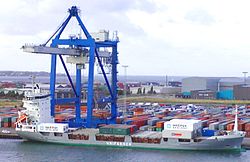Containerization
From Wikipedia, the free encyclopedia.

Part of an American doublestack container train loaded with 53 ft. containers
|
Containerization is a system of intermodal cargo transport using standard ISO containers that can be loaded on container ships, railroad cars, and trucks. There are three common standard lengths, 20 ft (6.1 m), 40 ft (12.2 m) and 45 ft (13.7 m). Container capacity (of ships, ports, etc) is measured in twenty-foot equivalent units (TEU, or sometimes teu). A twenty-foot equivalent unit is a measure of containerized cargo equal to one standard 20 ft (length) × 8 ft (width) × 8.5 ft (height) container. In metric units this is 6.10 m (length) × 2.44 m (width) × 2.59 m (height), or approximately 39 m3. Most containers today are of the 40-ft variety and thus are 2 TEU. 45 ft containers are also designated 2 TEU. Two TEU are referred to as one forty-foot equivalent unit (FEU). These two terms of measurement are used interchangeably. "High cube" containers have a height of 9.5 ft (2.9 m), while half-height containers, used for heavy loads, have a height of 4.25 ft (1.3 m).
Contents |
History

A container freight train in England
|
Containerization is an important element of the logistics revolution that changed freight handling in the 20th century. Malcolm McLean claimed to have invented the shipping container in the 1930s in New Jersey, but only founded Sea-Land Corporation in the 1950s.
McLean explained that while sitting at a dock waiting for cargo he trucked in to be reloaded onto a ship, he realized that rather than loading and unloading the truck, the truck itself (with some minor modifications) could be the container that is transported.
Containerization revolutionized cargo shipping. Today, approximately 90% of cargo moves by containers stacked on transport ships. Over 200 million containers are shipped per year.
The widespread use of ISO standard containers influenced modifications in other freight moving standards, gradually forcing removable truck bodies or swap bodies into the same sizes and shapes (though without the strength needed to be stacked), and changing completely the worldwide use of freight pallets which fit into ISO containers or into commercial vehicles.
Biggest container companies
| Top 12 container transportation and shipping companies (listed in order of number of ships & total equivalent units (TEU) 1 = a 20 ft container) |
|||
|---|---|---|---|
| 01 May 2005 | |||
| Company | Number of ships | Company | TEU |
| Maersk Sealand incl. Safmarine | 387 | Maersk Sealand incl. Safmarine | 1,036,582 |
| Mediterranean | 257 | Mediterranean | 681,334 |
| CMA CGM | 185 | P&O Nedlloyd * | 460,203 |
| P&O Nedlloyd * | 162 | Evergreen | 439,538 |
| Evergreen | 153 | CMA CGM | 412,007 |
| COSCO | 118 | APL | 315,879 |
| China Shipping C.L. (CSCL) | 111 | Hanjin-Senator | 298,173 |
| NYK Line | 105 | China Shipping C.L. (CSCL) | 290,089 |
| APL | 99 | COSCO | 289,800 |
| Pacific International Lines | 97 | NYK Line | 281,722 |
| Zim Integrated Shipping Services | 93 | OOCL | 237,318 |
| CSAV Group | 83 | CSAV Group | 215,992 |
(SOURCE: BRS-Alphaliner)
* Maersk acquired P & O Nedlloyd (13 August 2005), the new combined entity will be called "Mærsk Line" starting February 2006.
Other container systems
- Haus-zu-Haus (Germany)
- RACE containers (Australia)
See also
In fiction
The containerization system, containers, tracking of containers, and moving of containers is extensively made use of in the HBO television series The Wire.
External links
- Dimensions for shipping containers
- Container diagram and other information
- "The 20-Ton Packet" - Wired Magazine October 1999
- World Port Rankings 2002, by metric tons and by TEUs, American Association of Port Authorities (xls format, 26.5kb)
- Shipping Container Housing Guide
| Rail transport freight equipment | |
| Enclosed equipment | Autorack, Boxcar, Container, Covered hopper, Refrigerator car, Roadrailer, Stock car, Tank car |
| Open equipment | Flatcar, Gondola, Hopper car, Schnabel car |
| Non-revenue equipment | Caboose |



